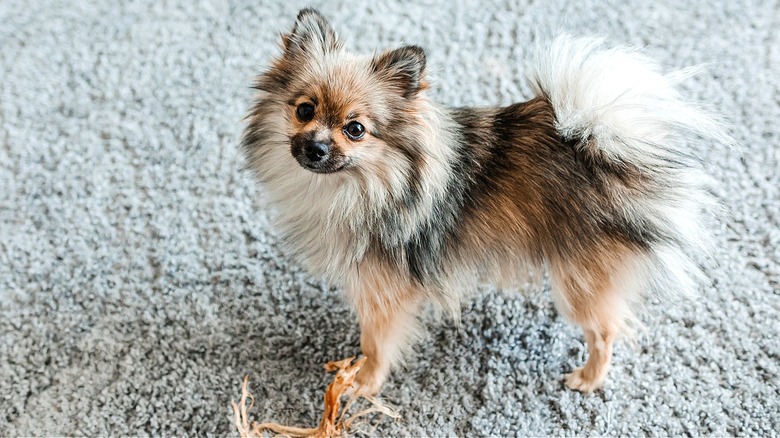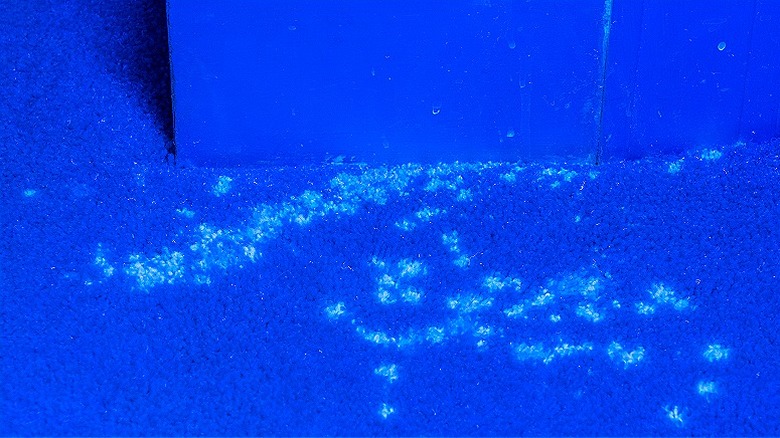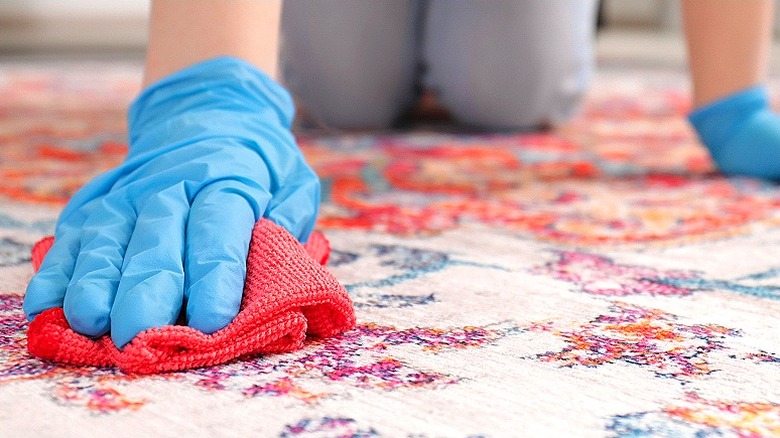The Handy Tool That Makes It Easier To Find And Clean Stubborn Pet Urine Stains
Is there a lingering musky, urine-like smell in your home, but you can't figure out where it's coming from? A black light may be all you need to find that hidden pet urine stain so you can finally get rid of it. Urine can dry clear, and once it does, it'll continue to smell bad even if you can't see the discoloration anywhere. More so, pet urine is really good about hiding, such as absorbing into the edges of drywall or wood flooring, getting deep into the carpet fibers, or becoming trapped even on your furniture's upholstery.
None of that sounds like fun to clean up, but knowing where the problem is helps to make the process more efficient and effective. Black lights can help illuminate the presence of pet urine on most surfaces, allowing you to better target the cleanup. How does it work? When shined on an area where you suspect pet urine to be, the black light's wavelengths will cause the urine to glow bright yellow due to the phosphorous in the urine.
How black lights can help to find pet urine stains
Tracking down where your cat decided to urinate on the carpet isn't always easy, especially when your pet is trying to hide what it's doing. Black lights work by illuminating anything on the surface that fluoresces. Some products, including organic materials like urine, have phosphorus atoms that will create a reflection when black light is shown on them. The black light causes these atoms to reflect the light back. Most bodily fluids will fluoresce like this whenever short-wavelength UV light is placed directly on them.
When you apply a black light to a carpet or couch, for example, in a very dark room, you'll notice certain things shine. Most bodily fluids will glow, often white in color, when the light touches them. Pet urine, though, will glow yellow, providing you with a clear indication of where you may need to target your cleaning.
To work, you'll need to hold the black light several inches from the surface of the area you're concerned with, and be sure to spread out several inches around that area to get a good idea of where all of the urine is. The black light doesn't cause any damage to the surfaces, but it may reveal a good amount of work to do for cleaning up. For the most effective results, use the black light in a completely dark room at night. That is going to allow your eyes to easily pinpoint the specific areas of concern.
How to clean up pet urine that's older
If the surface was wet, it'd be easy enough to pinpoint where the pet urine is and clean it up. Now that it's dry, though, the process becomes a bit more complicated, not just in tracking it down but also in cleaning away the material and the lingering odor.
One of the most effective dried pet urine removal options is to use a solution of white vinegar and water. Add equal parts to a spray bottle and then spray the area you've found contains the urine. Allow the solution to saturate the area well, and then let it sit for a couple of minutes. Once time's up, use a dry sponge or clean paper towels to blot up the moisture. This should pull up the urine along with the vinegar mixture, while the vinegar will work to neutralize the odor by getting rid of the bacteria present. Allow the area to fully air dry.
Other options to remove set-in pet urine stains include using a carpet cleaner, a specially designed pet stain remover for the type of surface, and a steam cleaner. You can also use a small amount of mild dish detergent along with hydrogen peroxide on the offending area and scrub it clean. It may take several applications to pull out all of the older, stubborn pet urine stains, but with a better, targeted approach using the black light, the process doesn't have to take so long.


